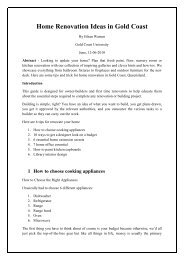Home Remodelling & Renovation
You also want an ePaper? Increase the reach of your titles
YUMPU automatically turns print PDFs into web optimized ePapers that Google loves.
Lime green, fuchsia, turquoise, purple, avocado green -- people were not afraid of colour in<br />
the '70s. Texture was also important (just check those carpets, and we loved a good shag<br />
pile rug).<br />
Architects and designer names of this era included Marion Hall Best, Leslie Walford, Nola<br />
Charles, Barry Little, Babette Hayes, Bryce Mortlock, Ken Woolley, Philip Cox, Michael<br />
Dysart, Glenn Murcutt.<br />
THE EIGHTIES: 1978-1987<br />
Moving into everyone's favourite decade to forget, townhouses rose in popularity. Stucco<br />
and rendered exteriors flooded in, as well as designer kitchens.<br />
The garden became more important, and bi-fold doors were in fashion. An extension of this<br />
was the popularity of green living, such as solar panels and recycling, and energy-efficient<br />
housing.<br />
Other design notes include Plantation-style louvres, and the rise of Neoclassicism: pillars,<br />
glass bricks and curves.<br />
The colours of the '80s were defined by pink, peach, apricot, celadon and teal teamed with<br />
grey and white. But don't forget your “Hot-Shot” brights – including pink, yellow and aquainspired<br />
Ken Done.<br />
Sophisticated moody hues, such as night sky and storm, with red highlights were also big.<br />
On the softer side, romantic punchy pastels like rose, hyacinth, and primrose were popular.<br />
Natural Australian hues including bottlebrush, banksia, wild honey, sandstone and ghost<br />
gum were a stylish choice.<br />
There were also lots of Provence sunflower yellows, cornflower blues with timbers, nautical<br />
blues and whites and primaries as accent colours.














